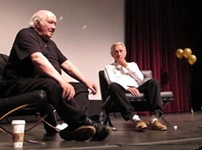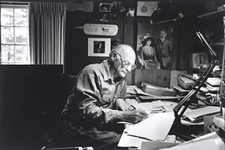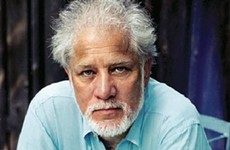Ransom Acquires Ruscha
Influential artist who made art of words sends archives to UT
By Robert Faires, 2:00PM, Thu. Nov. 14, 2013

In the era of Mad Men, as graphics and language were being manipulated in new ways for the purposes of commerce, Ed Ruscha was seeing what he could do with them for art. He did plenty. This West Coast painter and photographer became a key figure in the Pop and conceptual art movements, and now the Ransom Center has acquired his archives.

The New York Times reports the cost of the acquisition at $2 million, four-fifths of which was covered by donors, most significantly Michael and Jeanne Klein; the Marlene Nathan Meyerson Foundation; and Mark Wawro and Melanie Gray. The materials span the artist's full half-century career, from notes, contact sheets, and photographs for his very first groundbreaking artist's book, Twentysix Gasoline Stations (1962), to preparatory materials for his 2010 artist's edition of On the Road, by Jack Kerouac. Five personal journals reveal how Ruscha developed work in sketches and notations, and the finished products are represented by some 200 prints, print portfolios, 16mm prints of his films, and complete sets of exhibition posters and his remarkable artist’s books, a substantial portion of which the artist gave to the Ransom Center.
The center is more often thought of with regard to writers than artists, though Ruscha's interest in language – slang, catchphrases, palindromes, rhymes – and incorporation of it into his visual art, and his revolutionary development of artist's books, make the HRC a fitting place for his archives.
The Chronicle had an opportunity to speak with Ruscha by phone to learn more about his Oklahoma City upbringing, the lure of Los Angeles in the Fifties, when he went to school there and began his career, and what it means to him to have his work at the HRC.
Austin Chronicle: Have you been to the Ransom Center more than just recently?
Ed Ruscha: I originally went there five or six years ago, and that was my first knowledge of Ransom at all. And I could see that it was a very interesting place, needless to say. And then they were interested in acquiring what I did. it sounded like a solid home for all this materials that I've amassed over the years.
AC: Have you imagined how people might use this material at the Ransom Center?
ER: There's always a gap between what an artist does and his audience, so it's hard to say who my audience would be or if there would be one or if there would be, what interests they would have. So I just think that all this material that will end up at the Ransom will be just bits and pieces and thinking behind my work as an artist, and it all comes together in some kind of archival package that I would hope illuminates whatever I've been up to as a person and as an artist.
AC: Going back to your early years, was it inevitable that you would end up in Los Angeles? Was there a magnet pulling you there in your youth?
ER: I would say so. When I was leaving Oklahoma, I had a choice. I knew I wanted to go to art school, and I could think of this Art Center School in Los Angeles, Kansas City Art Institute, Chicago, and New York, and all that seemed kind of cold. And I had visited L.A. before, so I thought, "L.A. is the place to go, 'cause I have an affinity for it." And it had a real sparkle to it that I felt like these other cities may not have. So I headed west, and that's where it all started.
AC: And it seems like such a remarkable time when you got there. In the mid-Fifties, Los Angeles was growing so dramatically, but it was still small enough – and its art scene was still small enough – that you had a kind of freedom I'm not sure you would have had, say, 10 years later. Do you think you would have?
ER: Probably not. New York was really the center of the art world, and everything of consequence was happening there, and I didn't have the attraction to be in the swim of things. Liking L.A. as I did, I could see that it was the place to be for me. Eventually, I made contacts in New York and showed my work there, but I always relished the idea that I could be away from it and still be in a hopping, happening city.
AC: There's that sort of wild tension in that period between the slickness of Hollywood, with all the signage and iconography, with the homegrown simplicity to the signage? Did that appeal to you?
ER: It did, it really did. You know, a lot of my visions of the outside world when I was growing up got to me through movies. I saw evidence of Los Angeles in documentaries and even real movies that used actual street scenes. And likewise New York. My first trip to New York, I walked up and down the streets just knowing it was exactly the way I thought it would be. I'd seen it like that in movies so many times. So L.A. was just its own animal, really sparkly and glamorous, and i think the vegetation had a lot to do with it, too.
AC: Really?
ER: Yeah. Palm trees and cacti and all that, 'cause we're basically in a desert here. It had an appeal to me, a real appeal. So I went to art school – I didn't go to Art Center School, 'cause the quota was filled, so I went to my second choice, which was actually the best choice: Chouinard Art Institute, which was far better for me.
AC: Why was that?
ER: It was leaning toward a fine-art school rather than a commercial, industrial-design school, which Art Center was. They had an art program there, but Chouinard turns out to be the bohemian place – ways to think about new things and no restrictions or anything. Art center School at that time had a dress code, where you couldn't have facial hair, couldn't wear sandals, couldn't bring bongo drums to school, couldn't wear a beret, couldn't do anything like that. It was rather restrictive then.
AC: Seems almost anti-Californian.
ER: It does in a way, doesn't it? Yeah, but I guess they had to stay strict because they were on such a rigid commercial course, you know, getting people in the automobile industry and advertising and all that. Which they excelled at. It was a really great school for that. But Chouinard had the kooks and the beatniks, so that's where I ended up, and it served me much better.
AC: When you began to incorporate words into your work, were you receiving any encouragement from anyone in Los Angeles at the time, instructors or former instructors or peers?
ER: I got sort of mixed grades from people. I did this book called Twentysix Gasoline Stations, and they were photographs of gas stations, and I found that I could show that book to somebody who worked in a gas station, and they might say, "Oh, that's very interesting." Butif I showed it to some poet or intellectual, their take was, "Are you putting me on? Are you just fooling with us, or what?" But my work that I had done with words, I remember getting … Every artist has an idea about showing their work all around the world, you know, and I thought, "Well, maybe Europe would be great. My friends are having exhibits there, and why can't I do that?" [People there] would tell me, "Your work involves the English language, and we don't speak English here, so there might be a problem." As it turns out, there was no problem whatsoever about that, so I just kept on my own course.
AC: Well, if there's one thing America has exported, it's movies, so those same images that were hitting you in Oklahoma were hitting folks in Europe and all over the world.
ER: So true, so true.
AC: When you got to the point of making books, did you feel like you were pulling together all the different elements of what interested you – the visual elements, the language, the look and feel of type – together run a special package?
ER: Yeah. I ended up doing that because first of all, the main effort here was to make a book, and secondly I had to say, "What do I want to make a book about?" I had been taking these photographs of gas stations, and I thought, "That's an excuse to make a book." And I'd also studied typography and set type and worked for a book printer, so I really wanted to make a book. The book was the important thing, almost to the exclusion of the idea. I was eager to do that, even if it ended up being blank. So I went on from there.
AC: Was there ever a project where you felt like you were taking a bigger leap into the unknown or a bigger risk than you'd taken on any project before? Did you ever think in those terms?
ER: Well, being in unfamiliar territory, yes, I have, and it's kind of an edgy feeling but not that uncomfortable. It's almost like facing a frontier of a sunrise or a sunset and saying, "Here, something new is coming on this horizon, and I'll be part of it." But I have felt like, "What am I getting myself into? Is this fish or fowl, or what is it?" [Laughs]
AC: And sometimes it's a mix of both, and that's just what you need.
ER: Yeah, yeah. And you can't analyze it. You can't come up with an answer for it all. It's almost like searching for bones in ice cream or something. You're not gonna find it.
AC: Do you still go to the studio every day?
ER: Oh yeah. It's important to do that. I don't always accomplish a thing, and I don't just paint. I'm shuffling papers and looking at notes, and it's just like a scrabble of elements that I'm playing with throughout the day. But I usually have a few things that I'm working on. I might work on three or four things at once, and if you don't find me painting a picture, I'm usually off painting another picture.
AC: Are you a percolator? Do ideas take time to develop and bubble up to the surface?
ER: Sometimes, and sometimes, bang, they just happen. I mean, I might think of the words "meal ticket," and somehow "meal ticket" becomes something important to me, and it'll be far more profound than it ever has in my life, and I'll have to make a drawing of it or a painting of it. It's a matter of having blind faith in something that stirred me, and it just goes on from there.
AC: Will the journals that the Ransom Center is getting contain some of that? Would you write down words and phrases as they came to you?
ER: Yeah. I would. And kind of sketch them out and plot them and position them within a frame, a format, a formatic frame and then make comments on it and apply ideas until the final thing was done. But there were all kinds of references to my work at that time – mostly from the Sixties and Seventies. I did more extensive scribbles and notions and little fragments of ideas, but they all swirl around and make the final thing.
AC: Well, I'll bet there will be scholars and artists and aspiring artists who are going to find a lot of inspiration digging into these materials of yours.
ER: Well, everything they've got over there is intriguing, no doubt. And it has a particular appeal to people who want … obscure is not the word, but deeper, hidden things from an artist's or a writer's work. They may be just notions, but collectively, they make some kind of portrait, and you just hope that whoever digs it out will see that portrait.
A small selection of materials from the archive will be on display through Dec. 1 in the lobby of the Ransom Center, 21st & Guadalupe, UT campus. For more information, visit www.utexas.hrc.edu.
A note to readers: Bold and uncensored, The Austin Chronicle has been Austin’s independent news source for over 40 years, expressing the community’s political and environmental concerns and supporting its active cultural scene. Now more than ever, we need your support to continue supplying Austin with independent, free press. If real news is important to you, please consider making a donation of $5, $10 or whatever you can afford, to help keep our journalism on stands.
Rod Machen, Jan. 19, 2016
Robert Faires, Jan. 12, 2018
Robert Faires, Sept. 26, 2017
Sept. 24, 2021
Sept. 17, 2021
Ed Ruscha, Harry Ransom Center











